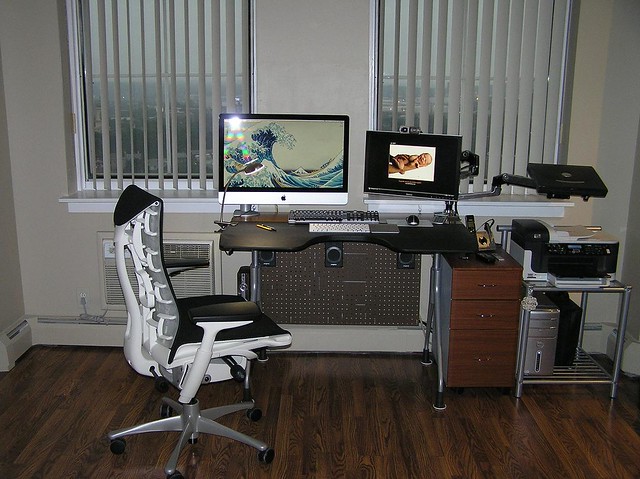Shifting trends have changed the meaning of what the typical office environment should be like. In the modern scenario, an office can mean the customer’s site, an employee’s home, or even a café.
Amid these changes, it can be extremely challenging to provide a stimulating and healthy work environment to employees.
The Bureau of Labor Statistics External reported that 31% of nonfatal occupational injuries in 2015 were related to musculoskeletal disorders.
Offices make use of several electronic devices desktops and laptops as well as furniture such as chairs and desks/tables. Understanding potential ergonomic issues and incorporating proper work practices for the improvement of ergonomic conditions can help boost comfort and productivity at the workplace.
What Is Office Ergonomics?
The National Institute of Occupational Safety and Health defines ergonomics as designing the workplace in a way that fits the capabilities of the workforce. This includes the appropriate design of equipment, work layouts, and work environment. They should match the capabilities of the workforce to help lead productive and healthy lives.
Differences in job tasks and body sizes among employees should be accommodated so that job hassles, soreness, and potential injury can be avoided.
The Occupational Safety and Health Administration, OSHA states that adapting tasks, workstations, tools, and equipment to suit workers helps reduce physical stress on a worker’s body. It also helps eliminate work-related Musculoskeletal Disorders (MSDs).
What Are Ergonomic Injuries?
Ergonomic injuries or musculoskeletal disorders (MSDs) are soft tissue injuries of the muscles, nerves, tendons, ligaments, joints, cartilage, blood vessels or spinal discs. They are as a result of gradual exposure to risk factors. Prolonged exposure to risk factors can result in the body’s reduced ability to function properly and heal.
The three primary ergonomic risk factors that cause MSDs are:
-
Improper Postures
Postures that lead to the bending of joints in positions that can lead to injuries must be avoided in the place of work. For example, slouching or leaning forward in the chair, holding the phone between the ear and shoulder, constantly bending while performing actions, and reaching over to access input devices.
-
Heavy Force
Constant force applied on muscles may result in ligament strains, swelling, and fatigue. Repetitive tasks like holding folders, operating a mouse or typing on a keyboard can also result in injuries.
-
Prolonged Exertions
Prolonged exertion can occur when the muscles hold the body in a particular position for a longer duration. This results in muscle tension. For example, staring at the monitor or sitting in a fixed posture for an extended period of time without breaks.
It is important that employers educate their staff about these ergonomic risks and provide appropriate solutions like appropriate seating arrangements and other equipment to curb related health issues. Furthermore, employees must ensure that they strictly adhere to the SOP provided by the employer to avoid injuries.
Here are a few ergonomic considerations that will help identify and reduce injuries among office workers.
1. Identify Ergonomic Challenges
This three-step process will help identify ergonomic challenges in the workplace:
- Closely observe the workplace.
- Conduct formal risk assessments to identify and document risks.
- Try to find a workaround.
2. Deal with Ergonomic Issues
Find below a few ways to correct ergonomic issues at workplace.
- Eyes to Source
-
- Adjust the height of the computer’s monitor so the top of the display is at the same line or slightly below the user’s eyesight.
- Ensure to place the monitor at an arm’s reach. If there is a problem due to reflected glare, tilt the screen of the system slightly forward.
- Hands and Input Devices
-
- Place the keyboard in a way that the upper arms and forearms are comfortable when using it. Ensure that the elbows are placed at a 90 degree.
- The mouse or input device near the keyboard should be at the same level as that of the keyboard.
- Make sure that the hands and arms are comfortably placed while typing.
- Body to Chair
-
- The feet should rest on the floor with two-finger space between the chair and back of the knee.
- Make sure that the seat is moved backward until it supports the entire back.
- Raise the seatback until the lumbar bulge fits into the lumbar curve at the back.
- Feet to Floor
-
- Feet should be placed flat on the floor or an appropriate footrest. Make sure not to sit on the legs or prop them on the chair legs.
3. Healthy Habits to Consider
A few healthy habits that help reduce exposure to ergonomic risks are:
- Vision Breaks
Vision breaks can last a few seconds and should be repeated throughout the day. Periodically, look away from the monitor and focus on something that is placed at a distance. Ensure to follow the 20-20-20 rule. Look approximately 20 feet away every 20 minutes for 20 seconds.
- Regular Breaks during Tasks
Shuttle between activities to reduce ergonomic risks. For example, take a break from typing by making calls, filing documents or making copies. It is ideal to take a 5-minute break after an hour of typing.
- Stretch Breaks
Stretch to get relief from prolonged postures, but not to the point of pain or discomfort.
- Work Practices
Modify work procedures to avoid uncomfortable postures. Adhere to Standard Operating Procedures (SOP). Use equipment that is best suited for particular tasks.
Also, ensure to do the following:
-
- Get properly trained to recognize work-related Musculoskeletal Disorders (WMSDs) risks and to take appropriate action to reduce exposure to the risks.
- Obtain knowledge about SOPs and correct use of equipment.
- Encourage colleagues and immediately report equipment deficiencies to maintenance and management personnel.
4. Legal Ways to Deal with Ergonomic Issues at the Workplace
According to the General Duty Clause, Section 5(a)(1), it is important to keep workplaces free of ergonomic risks that can result in improper posture, repetitive tasks, and prolonged exertion.
The current system does not hold employers liable for the consequences of ergonomic issues in the workplace explicitly. The injured employee will need to prove that injury or damage has been caused by the scope of employment to obtain fair compensation.
If you are working for an employer in Mount Vernon and are experiencing ergonomic issues at your workplace, you can consult a Mount Vernon workers compensation lawyer for further legal assistance. Only an experienced lawyer will help you hold your employer accountable if they deny the responsibility or if the claim is rejected.
Based on the General Duty Clause, OSHA uses the following basic criteria to analyze an ergonomic issue:
- If an ergonomic hazard exists.
- Whether that particular hazard is recognized.
- If the identified hazard is impacting the employees.
- If there are ways to curb the ergonomic issue.
Wrap Up
Ergonomic considerations are an important part of workplace safety. Prolonged exposure to these concerns may result in heavy damage to the physical and mental health of employees. It is, therefore, important for both the employees and employers to pay due attention to these considerations. The above-mentioned information will help in the identification of and curb ergonomic issues along with nurturing a healthy workforce.



